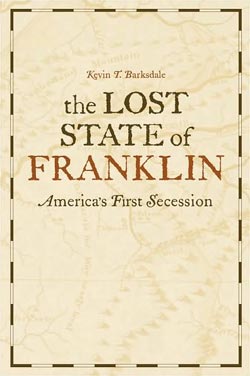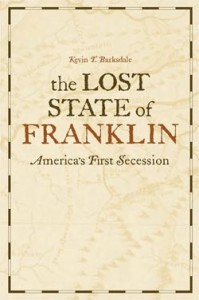A Lost Cause

Kevin Barksdale’s new book, The Lost State of Franklin: America’s First Secession, describes the trials and many tribulations of a handful of settlers in the Tennessee Valley who bumbled through a short-lived effort to become America’s fourteenth state. Perhaps “bumbled” is unfair. The ambitions and deep convictions of those who forged the state of Franklin out of the North Carolina backcountry fueled fierce conflicts, both rhetorical and physical, that seared long-lasting legacies into the local history of east Tennessee.
But sometimes, the Franklinites’ desperate quest for legitimacy led to episodes that were downright funny. Throughout the Franklinites brief claim to statehood between 1784 and 1788, nobody gave them much respect. North Carolina would not recognize them. Congress did not support them. When the Franklinites sent a delegate to New York to lobby Congress for recognition, Patrick Henry observed that the “mission was fruitless” (67). At one low point, the Franklinites decided that the only person who might lend them some credibility was Franklin himself—Benjamin, that is—so they wrote the aging founder to see if he might back them up. Franklin never replied. Meanwhile, in east Tennessee, infighting over statehood ripped the region apart, at one point bringing the two partisan leaders, John Sevier and John Tipton, to fisticuffs in open court. Desperate to hang on to their dream, the Franklin lobby appealed to the state of Georgia for recognition. They toyed with the idea of annexing themselves to Spain. They carried on in their seemingly quixotic quest for statehood until, finally, Franklin was “lost.”
The Franklin statehood movement emerged out of a context in which meanings of statehood and sovereignty were profoundly unclear and dangerously fragile. In elaborate detail, Barksdale documents the ways that Franklin’s leadership navigated such ambiguity to claim political legitimacy. North Carolina legislators initially claimed sovereignty over the Tennessee Valley but ceded their western lands to Congress in 1784. The state of Franklin emerged out of this cession, its leaders asserting that local sovereignty was the only way to protect the interests of backcountry settlers. Almost immediately, North Carolina legislators changed their minds and took back the land they had just ceded to Congress. The result was overlapping claims that created, as one observer noted, a “strange spectacle of two empires exercising at one and the same time over one and the same people” (73). Add to this mix resident Cherokee and Creek people who were, in turn, also struggling to redefine Indian sovereignty amidst internal dissent. The result was a volatile set of competing claims, each as legitimate (or ephemeral, depending on perspective) as the next.
The Lost State of Franklin presents a fascinating portrait of Franklin’s history, but remains largely local in focus. Barksdale closely documents negotiations within the state, yet rarely steps outside of regional conflicts to explain the broader consequences of backcountry instability. To the detriment of his overall argument, Barksdale’s narrative remains bounded by long-standing historiographical debates over the nature of the Franklin enterprise: were the Franklinites loyal patriots, following in the revolutionary tradition, or were they disloyal opportunists scheming against the new republic? Barksdale charts out a path between these two positions, pointing out that Franklin’s leadership was all of these things at once.
But Franklin’s significance was really far bigger than that. In the late eighteenth century, the Franklinites’ claims to sovereignty compounded pressures emerging along the western borders of New York, Virginia, Massachusetts, and Pennsylvania. As Patrick Griffin has powerfully argued in American Leviathan, the ambiguity of sovereignty in the early national West granted backcountry settlers enormous license to invent and re-invent structures of authority and legitimacy. The sovereign vacuum created by the inability of any power to serve the needs of backcountry settlers politicized the early national West. The state of Franklin was but one of many movements for self-sovereignty to emerge in the wake of war. Taken together, the reality and variety of creative self-sovereignty forced early national leadership to take note and to seek remedies against the increasingly real possibilities of fragmentation and disunion in the backcountry.
Questions about the broader implications of Franklin’s claims to sovereignty loom large in Barksdale’s analysis but seldom take center stage. Instead, the author delves deep into the personal and financial motivations of Franklin’s leaders and argues that Franklin emerged out of the “regional influence [of the ruling class], their shared wartime and frontier experiences, and their collective political and financial interests” (15). Local politics and regional demands fueled the Franklin movement. Yet, while such local motivations were certainly central, they tell only part of the story. Barksdale could have granted Franklin a much greater significance by placing it within the larger framework of political experimentation and creative invention that characterized the post-war frontier. Doing so would have positioned Franklin within a much broader context to explain how the collective pressures of backcountry claims to sovereignty forced early national leaders to recognize the fragility of their hold on western populations.
In many ways, the most interesting part of Barksdale’s analysis lies in his descriptions of what has happened to the state of Franklin since the eighteenth century. In the two hundred plus years since the Franklin experiment, historians have interpreted the episode in ways that reflect variously noble, patriotic, ruthless, insidious, and downright shady motives. One of the most compelling aspects of Barksdale’s work is his description of Franklin’s historiographic malleability. The conflicts that emerged in east Tennessee persisted in memory as “the continued evolution of the meaning of Franklin allowed several prominent American figures to recast the movement for their own political purposes” (163). The very title of his book points to the loaded historiographical baggage that weighs on the Franklin story. Franklin was not always “lost,” but became so during the 1880s when historians looked to the episode as east Tennessee’s own version of the “Lost Cause.” Only after the Civil War did southern historians champion Franklin as “America’s first secession” movement, vindicating the ambitions of backcountry separatists against the invasive claims of North Carolina.
Of course, there is deep irony in claiming Franklin as “lost” as a means to vindicate states’ rights ideology. The Franklinites’ whole crusade emerged during a moment when the very idea of statehood was profoundly vague. Their creative attempts to carve a new state out of the Tennessee Valley amid the chaos that followed the American Revolution raised the very questions from which the meaning of statehood emerged. The state of Franklin forced early national leadership to face core questions about what a state should be and how it should be constituted. Labeling the Franklin movement as “America’s First Secession,” therefore, grants early national concepts of statehood a level of coherence and stability possible only in hindsight.
This article originally appeared in issue 9.4 (July, 2009).
Honor Sachs teaches at Southern Connecticut State University. Her book, Chosen Land: The Legal Creation of White Manhood on the Eighteenth-Century Kentucky Frontier, is forthcoming. She lives in New Haven, Connecticut, with her dog, Blue.
